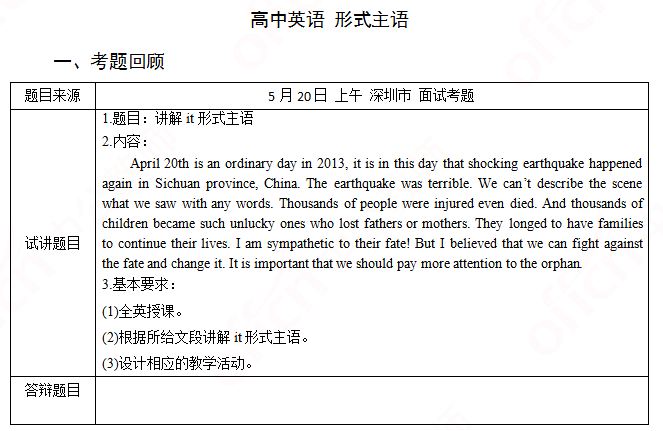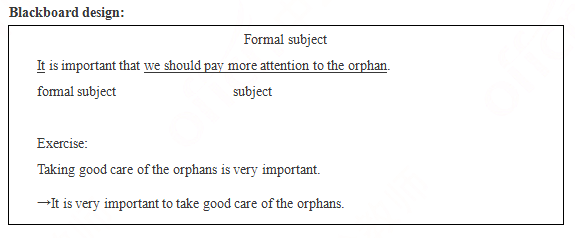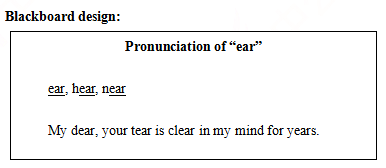What tricks can a teacher teach his students to use to memorize vocabulary?
题目
What tricks can a teacher teach his students to use to memorize vocabulary?
相似考题
更多“What tricks can a teacher teach his students to use to memorize vocabulary?”相关问题
-
第1题:
In an English class,the teacher,firstly,plays the radio and asks students to listen to the tape and understand the dialogue.Then,the teacher asks students to read after the tape to imitate the pronunciation.Next,the teacher asks students to repeat the dialogue in pairs...What teaching method does the teacher use in this class?A.Communicative Approach.
B.Task-Based Teaching Approach.
C.The Audio-Lingual Approach.
D.The Audio-Visual Approach.答案:C解析:本题考查听说法
C选项,题干大意:老师采取的是“听音理解对话的含义——模仿——重复”这样一个教学过程,因此,该教师使用的是听说法。综上,C选项正确。
A选项,交际法,故排除。
B选项,任务型教学法 ,故排除。
D选项,视听法 ,故排除。
故正确答案为C项。 -
第2题:
A teacher asked the students to repeat a word many times to memorize the pronunciation,meanings and usages.Which conclusion is NOT correct?A.The teacher is teaching pronunciation.
B.The teacher focuses on accuracy.
C.The teacher is using mechanical practice.
D.The teacher is teaching vocabulary.答案:A解析:考查词汇教学
一位老师让学生重复了一个生词很多遍,以此来记忆该生词的发音、意思和用法。以下结论哪个不正确?
A是老师正在教授发音,题干中不仅说到了发音,还说到了意思和用法,这都是词汇教学的内容,故此题的正确选项为A。
B是这个老师注重准确性,不合题意,故排除。
C是老师正在使用机械练习法,不合题意,故排除。
D老师正在教授词汇,不合题意,故排除。
故此题的正确选项为A。 -
第3题:
During class, the teacher leads students to memorize the important points of the teaching content. On one hand, the teacher helps students to grasp the key points. On the other hand, what learning strategy is the teacher teaching?A.Cognitive strategy
B.Self-management strategy
C.Communication strategy
D.Resource strategy答案:A解析:本题考查英语学习策略
A选项,老师在教学中引导学生对教学要点进行记忆,一方面是为了让学生了解课程内容的重点,另一方面是为了传授学生学习策略,而在学习中记住要点是属于学习策略中的认知策略。综上,A选项正确。
B选项,自我管理策略,故排除。
C选项,交际策略 ,故排除。
D选项,资源策略 ,故排除。
故正确答案为A 项。 -
第4题:
When students learn "apple, orange", the teacher gives students another word "fruit".Which principle doe, s the teacher follow in his/her vocabulary teaching?A.Word-choice principle.
B.Presentation principle.
C.Culture principle.
D.Systematic principle.答案:D解析:考查词汇教学的原则。系统性原则是指在词汇教学时要注意给学生展示词汇之间的系统性和联系性,如音形关系、形意关系、词形变化关系、反义词、同义词、上下位词等。题干中教师展示的词汇的上位词,故选D。A项指“词汇选择原则”,指选择目标词汇时,应当选择具有代表性的、能够用于其他活动的、经常出现的词汇。B项指“展示原则”,指展示新词时应当将其直观化、情景化和趣味化。C项指“文化原则”,是指语言是文化的载体,词汇结构、词义结构和搭配都该与该语言的文化相连。 -
第5题:
When a teacher corrects the errors of his/her students,what measures shouldn’t ,he/she use at first?A.To give the students who makes error the first opportunity to correct it.
B.B. To get other students to correct it.
C.C. To correct the student directly.
D.To hint students their errors.答案:A解析:本题考查教师的指令。
根据题干“Quiet now, please”,教师是想让学生停止讲话,A选项为题干的同义反复,综上,A选项正确。
B选项,帮助学生纠错,故排除。
C选项,小组中改变角色,故排除。
D选项,告诉学生要结对学习,故排除。
故正确选项为A。 -
第6题:
What vocabulary learning strategy does the following activity help to train?
The teacher created a situation and asked students to think of words and expressions that can be used in that situation.A.Association.
B.Generalization.
C.Collocation.
D.Contextualization.答案:D解析:考查词汇教学。该教师在词汇教学中创造情境,让学生了解词汇在具体情境下的使用,属于情境教学法,故选D。 -
第7题:
When students learn"apple, orange", the teacher gives students another word "fruit".Which principle does the teacher follow in his/her vocabulary teaching?A.Word-choice principle.
B.Presentation principle.
C.Culture principle.
D.Systematic principle.答案:D解析:考查词汇教学原则。系统性原则是指在词汇教学时要注意给学生展示词汇之间的系统性和联系性,如音形关系、形意关系、词形变化关系、反义词、同义词、上下位词等。题干中教师展示的词汇的上位词,故选D。A项指“词汇选择原则”,指选择目标词汇时,应当选择具有代表性的、能够用于其他活动的、经常出现的词汇。B项指“展示原则”,指展示新词时应当将其直观化、情景化和趣味化,C项指“文化原则”.是指语言是文化的载体,词汇结构、词义结构和搭配都该与该语言的文化相连,、 -
第8题:

二、考题解析
【教案】
Teaching aims:
Knowledge aim: Students can master the usage of formal subject.
Ability aim: Students can use formal subject to communicate in their daily life.
Emotional aim: Students can enhance their interest in learning English.
Key and difficult point: Students can use formal subject to communicate in their daily life.
Teaching procedure:
Step 1: Warming-up
The teacher plays a documentary video about the earthquake in Wenchuan. Then asks students to talk about their feelings after watching. And lead in the topic.
Step 2: Presentation
The teacher lets students to read the passage and get the main idea. Then the teacher picks the last sentence out. The teacher will use the sentence as example to explain the structure and usage of formal subject.
Step 3: Practice
After explaining, the teacher will show some normal sentences. Students should transfer them into formal subject structure.
For example: Taking good care of the orphans is very important.
→It is very important to take good care of the orphans.
Step4: Production
The teacher lets students talk with their deskmates. They should come up with some ways to help the orphans. Then invites some students to show their opinions.
Step5: Summary and Homework
The teacher summarizes what they have learnt today. Then after class, students could say something to these orphans and take a video. The teacher will help them sent it to the orphan.

答案:解析:暂无解析 -
第9题:
What tricks can a teacher teach his students to use to memorize vocabulary?
a) grouping words in one way or another;
b) using dictionaries;
c) establishing personal category sheets;
d) using visuals;
e) using alphabetical index;
f) labeling.
略 -
第10题:
单选题During class, the teacher leads students to memorize the important points of the teaching content. On one hand, the teacher helps students to grasp the key points. On the other hand, what learning strategy is the teacher teaching?ACognitive strategy.
BSelf-management strategy.
CCommunication strategy.
DResource strategy.
正确答案: B解析: -
第11题:
问答题What are the techniques which you can use to teach intonation in a meaningful way?正确答案: To teach intonation in a meaningful way, we could choose from the following ways:
1) Using realia to set up a situation that would illustrate the difference in attitude.
2) Using mood cards.
3) Creating roles.解析: 暂无解析 -
第12题:
问答题What tricks can a teacher teach his students to use to memorize vocabulary?正确答案: a) grouping words in one way or another;
b) using dictionaries;
c) establishing personal category sheets;
d) using visuals;
e) using alphabetical index;
f) labeling.解析: 暂无解析 -
第13题:
When a teacher corrects the errors of his/her students,what measures shouldn’t ,he/she use at first?A.To give the students who makes error the first opportunity to correct it.
B.To get other students to correct it,
C.To correct the student directly.
D.To hint students their errors.答案:C解析:本题考查教学反馈。当老师首先纠正学生的错误时,教师首先不应该采取什么措施?
C选项,教师直接给学生纠正。学生犯错时,教师首先并不适合直接纠错,而应当引导学生纠错,综上,C选项正确。
A选项,首先给犯错的学生一次纠错的机会。表述正确,故排除。
B选项,让其他学生来纠正。表述正确,故排除。
D选项,教师提示学生错误。表述正确,故排除。
故正确选项为C。 -
第14题:
To assess how well students are able to apply what they have learned in completing a given task, a teacher would use __________assessment.A.performance
B.self
C.competence
D.peer答案:A解析:考查英语教学评价。表现性评价是指衡量学生在完成给定的一个具体任务或一系列任务时的水平。因此.为了评估学生在完成一项给定的任务中对所学知识的运用程度,教师应该用表现性评价。故选A。 -
第15题:
How should the teacher deal with students' writing errors?A.Teachers should limit students to take risks to use new vocabulary and structures.
B.Teachers should often show negative attitude towards students' writing errors.
C.Teachers should make corrections for all the writing errors of students.
D.Teachers should underline the errors and leave them for students to correct themselves.答案:D解析:考查写作教学。学生在写作中犯错常常是难以避免的情况.但是教师要不怕学生犯错并鼓励他们运用较难的词汇和句子,这样学生的写作能力才会提高,故A错误。教师如果经常对错误持消极的态度,就会阻碍学生的写作热情,不利于写作技能的提高,故B错。教师在批阅作文时,不应该自己把所有的错误都改正,而应该指出错误并让学生自己去改,以培养学生独立写作的能力,C项错误,故选D。 -
第16题:
What vocabulary learning strategy does the following activity help to train?
The teacher created a situation and asked students to think of words and expressions that can be used in that situation.A.Association.
B.Generalization.
C.Collocation.
D.Contextualization.答案:D解析:考查词汇教学。该教师在词汇教学中创造情境,让学生了解词汇在具体情境下的使用,意在训练学生在情境中学习词汇的学习方法.故选D。 -
第17题:
Which of the following should a teacher avoid when his/her focus is on developing students' ability to use words appropriately?A.Teaching both the spoken and written form.
B.Teaching words in context and giving examples.
C.Presenting the form, meaning, and use of a word.
D.Asking students to memorize bilingual word lists.答案:D解析:本题考查语言知识教学。题干的意思:如果教师专注于培养学生恰当地使用单词的能力,那么他/她应该避免以下哪种方式A项“教单词的口语和书面形式”,B项“在语境中教单词并举例子”,C项“呈现单词的形式、意义及用法”,D项“要求学生记忆双语单词表”。在词汇教学中,教师不仅要讲授单词的形式,还要创设具体的语境,让学生在运用中加深对词汇意义的理解,掌握词汇的用法和功能,进而恰当得体地运用词汇表情达意。记忆双语单词表属于单纯的记忆活动,不能起到促进学生恰当使用词汇的作用。故本题选D。 -
第18题:
During class,the teacher leads students to memorize the important points of the teaching content.On one hand,the teacher helps students to grasp the key points.On the other hand,what learning strategy is the teacher teaching?A.Cognitive strategy.
B.Self-management strategy.
C.Communication strategy.
D.Resource strategy.答案:A解析:本题考查新课标相关的英语学习策略
A选项,认知策略,老师在教学中引导学生对教学要点进行记忆,一方面是为了让学生了解课程内容的重点,另一方面是为了传授学生学习策略,而在学习中记住要点是属于学习策略中的认知策略。综上,A选项正确。
B选项,自我管理策略,故排除。
C选项,交际策略 ,故排除。
D选项,资源策略 ,故排除。
故正确答案为A 项。 -
第19题:

二、考题解析
【教案】
Teaching aims
Knowledge aim: students will know the pronunciation of the group of letter “ear”.
Ability aim: students can read words with “ear” when they learn vocabulary.
Emotional aim: students will be more interested in speaking English.
Key and difficult points:
How to pronounce the group of letter “ear”.
Teaching procedure:
Step 1: Warming-up
After greeting students, the teacher plays a game to warm up the class: I say you point. The teacher speaks out a certain part of the body and students point it quickly. For example: point your eye! Point your ear! Point your hand!
Step 2: Presentation
Draw a ear on the blackboard and ask students what it is. Write down the word. Then ask what ears can be used to, and they will say we use ear to hear something. Write down word “hear”. Then do the action of hearing and put hands near the ear, and write down the word “near”.
Ask students to read the three words after the teacher, and find out the similarity among them. After discussion, they will say all these words have “ear”. Then ask students how to pronounce this group of letter. We will know it pronounce as /ir/.
Step 3: practice
Give students some other words with the group of letter “ear” and ask students to read them by groups. For example, a sentence “my dear, your tear is clear in my mind for years”. Then students can have a brainstorming and think of more words with “ear”.
Play a game Hot potato to practice these words. The teacher plays a piece of music. When the music is playing, students pass the ball from one to another. When the music stops, the one who gets the ball should read words on the blackboard.
Step4: Production
Do a chant with students: put your ear, near my ear, and you will hear, and you will hear, and you will hear, NOTHING!
 答案:解析:暂无解析
答案:解析:暂无解析 -
第20题:
What are the techniques which you can use to teach intonation in a meaningful way?
To teach intonation in a meaningful way, we could choose from the following ways:
1) Using realia to set up a situation that would illustrate the difference in attitude.
2) Using mood cards.
3) Creating roles.
略 -
第21题:
单选题How should the teacher deal with students' writing errors?ATeachers should limit students to take risks to use new vocabulary and structures.
BTeachers should often show negative attitude towards students' writing errors.
CTeachers should make corrections for all the writing errors of students.
DTeachers should underline the errors and leave them for students to correct themselves.
正确答案: B解析: -
第22题:
单选题What is Mr. Weeks proud of?AAll his students have become famous persons.
BAll his students often write to him.
CSome of his students have been famous.
DHe’s been a teacher for twenty-six years.
正确答案: B解析:
细节理解题。第一段倒数第二句提到“Some of his students have become famous persons, but they still remember him and often write to him. ”可知,他的一些学生变得很出名,C项表述正确。 -
第23题:
单选题Which of the following should a teacher avoid when his/her focus is on developing students' ability to use words appropriately?ATeaching both the spoken and written form.
BTeaching words in context and giving examples.
CPresenting the form, meaning, and use of a word.
DAsking students to memorize bilingual word lists.
正确答案: B解析: -
第24题:
单选题What vocabulary learning strategy does the following activity help to train? The teacher creates a situation and asks students to think of words and expressions that can be used in that situation. _____AAssociation
BGeneralization
CCollocation
DContextualization
正确答案: D解析:
该教师在词汇教学中创造情境,让学生了解词汇在具体情境下的使用,这属于情境教学法。
